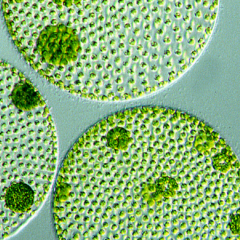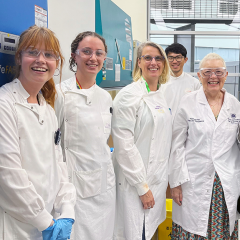For the first time, scientists have seen in exquisite, real-time detail how immune cells survey their surroundings to detect threats to our health. The imaging also provides insights into how aggressive cancer cells sustain their growth.
Dr Adam Wall and Dr Nicholas Condon from Professor Jenny Stow's lab at UQ's Institute for Molecular Bioscience, discovered new structures they termed ‘tent-pole ruffles’ on the surface of immune cells called macrophages; the ruffles help the cells gulp the surrounding fluid for sampling.
"It's really exciting to be able to see cell behaviour at unprecedented levels of resolution," Dr Wall said. "This is discovery science at the cutting edge of microscopy and reveals how much we still have to learn about how cells function."
Green 'tent-pole' ruffles project out in real time, from living macrophage cells, to help them gulp surrounding fluid. (c) Journal of Cell Biology
Macrophages (Greek for 'big eaters') are a type of white blood cell, whose job it is to detect and engulf any material that may be a potential danger to our health – such as debris of old cells, microbes, cancer cells and foreign substances.
They survey all tissues of the body by taking in large gulps of surrounding fluid to identify anything they don't recognise as healthy, triggering immune responses when necessary to ward off infection.
Gulping immune cells seen in exquisite detail
The scientists were able to record the gulping mechanism, known as macropinocytosis, in real time on live cells using a cutting-edge laser microscope called a lattice light sheet, which captures huge 3D images with great precision, in just seconds.
The tent-pole ruffles – projections with membrane strung between them – allow the macrophages to capture especially large gulps of fluid, Dr Wall said.
This revolutionary imaging, published this week in the prestigious Journal of Cell Biology, redefines scientists' understanding of the macropinocytosis process, and immune function and more broadly, Professor Jenny Stow says.
"This imaging will give us phenomenal power to reveal how cell behavior is affected in disease, to test the effects of drugs on cells, and to give us insights that will be important for devising new treatments" she said.
In cancer, for instance, the process of macropinocytosis is needed by aggressive cancer cells to gulp in the nutrients they need to sustain growth. Cancer cells also form ‘tent-pole ruffles’ and the scientists are now pursuing molecules they have identified on the tent-pole ruffles as targets for blocking cancer cell survival.
With support from the Australian Cancer Research Foundation and the Australian Research Council, the lattice light sheet microscope now operates in IMB’s Microscopy Facility where scientists are using it to view more new and detailed cell behaviours.



